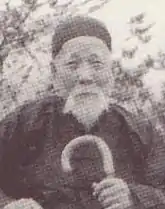Shouson Chow LLD, JP | |
|---|---|
 Sir Shouson in 1952 | |
| Unofficial Member of the Executive Council | |
| In office 9 July 1926 – 8 July 1936 | |
| Appointed by | Sir Cecil Clementi Sir William Peel |
| Preceded by | Paul Chater |
| Succeeded by | Robert Kotewall |
| Senior Chinese Unofficial Member | |
| In office 1922–1931 | |
| Preceded by | Lau Chu-pak |
| Succeeded by | Robert Kotewall |
| Personal details | |
| Born | 13 March 1861 Wong Chuk Hang, Hong Kong Island, Hong Kong |
| Died | 23 January 1959 (aged 97) |
| Alma mater | Queen's College, Hong Kong Winsted Local Grammar School |
| Shouson Chow | |||||||||||
|---|---|---|---|---|---|---|---|---|---|---|---|
| Traditional Chinese | 周壽臣 | ||||||||||
| Simplified Chinese | 周寿臣 | ||||||||||
| |||||||||||
| Chow Cheong-Ling | |||||||||||
| Traditional Chinese | 周長齡 | ||||||||||
| Simplified Chinese | 周长龄 | ||||||||||
| |||||||||||
Sir Shouson Chow (Chinese: 周壽臣; pinyin: Zhōu Shòuchén; 1861–1959), KBE, LLD, JP, also known as Chow Cheong-Ling (Chinese: 周長齡; pinyin: Zhōu Chánglíng), was a Hong Kong businessman. He had been a Qing dynasty official and prominent in the Government of Hong Kong.
Family
Chow is said to have been born in Wong Chuk Hang San Wai, a village at the foot of present-day Shouson Hill. Wong Chuk Hang San Wai was a village of a Chow lineage.[1]
His father was compradore of the Canton-based Canton and Hong Kong Steamship Company. His grandfather was the head of "Little Hong Kong", who helped Charles Elliot post the first official proclamation of Hong Kong Island in 1841. He had a son, named Chow Yat-Kwong.
Career
Among the third group of Chinese students sponsored by the Qing government to the United States in the 1870s,[2] Chow left China in 1874 and studied at Phillips Academy, Andover (class of 1880)[3] After his graduation, he was originally granted admission offer of Columbia University, but his studies ended due to recall of students by the Qing government. Then he worked for the Qing government after returning to China.
In 1881 he joined the Korean Customs Service under Yuan Shikai. Later he was the president of the China Merchant Steam Navigation Company of Tianjin from 1897 to 1903, and the managing director of the Peking-Mukden Railway between 1903 and 1907.
He was the Customs and Trade Superintendent and Counselor for Foreign Affairs in Niuzhuang between 1907 and 1910. During this period he was promoted to Mandarin of the Second Rank. He left government service after the 1911 Revolution and became director of various companies and charities.
Public Service


Chow was appointed a Justice of the Peace in Hong Kong in 1907. He was subsequently elected to membership of the North British Academy of Arts.[2][4]
In 1918, he founded the Bank of East Asia with three Chinese partners where he was the chairman of the board from 1925 to 1929. In 1922 he was appointed a member of the Sanitary Board, the precursor of the Urban Council, and the Legislative Council, where he served until 1931.
In 1926, he became the first Chinese member of the Executive Council, and was knighted. In 1933, he was awarded an honorary Doctorate of Laws.
During the Japanese Occupation of Hong Kong, Chow and other leading Chinese figures joined the Chinese Cooperative Council founded by the Japanese military which he was the chairman to maintain public order among the Chinese population. They did not suffer punishment for this collaboration after the return of British rule.
Memory
Shouson Hill, in the south of Hong Kong Island, is named after him.
External links
- Chow Cheong-ling (Zhou Changling) 周長齡 from Biographies of Prominent Chinese c.1925.
References
- ↑ Antiquities and Monuments Office. Wong Chuk Hang San Wai, amo.gov.hk. Accessed 8 August 2023.
- 1 2 Chinese Educational Mission Connections 1872–1881 – Chow Chang Ling
- ↑ Phillips Academy Notable Alumni: 1800s Archived 5 November 2013 at the Wayback Machine
- ↑ Document III.1: Mr. Chou Show Son p118-9 in A Documentary History of Hong Kong Society, ed David Faure, Hong Kong University Press, Hong Kong 1997